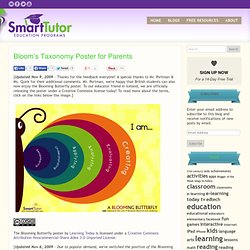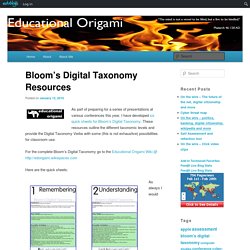

Blooms taxonomy. NoelleCombsInquiryLesson (PDF) Blooming Orange: Bloom's Taxonomy Helpful Verbs Poster. Here’s another poster to help get you thinking about how you can apply Bloom’s higher-order thinking skills with your children.

This poster shows the segments of an orange with each segment relating to a thinking skill and some helpful verbs to serve as prompts. While there are many more verbs that we could have added, we felt that including just seven in each segment would make them easier to remember (For more information, see Miller’s paper “The Magical Number Seven, Plus or Minus Two: Some Limits on Our Capacity for Processing Information.” We thought it would be interesting to depict the verbs in a circular form as opposed to a hierarchical list, given that these skills don’t often occur in isolation and are interconnected.
We went through several concepts including a wheel, a pie, and an apple, but somehow the orange seemed to work best when we put everything together. For those of you who prefer it, we’ve also created a grayscale version of the poster. Download the pdf’s here: Bloom’s Taxonomy Poster for Elementary Teachers. [Updated Nov 9, 2009 - Thanks for the feedback everyone!

A special thanks to Mr. Portman & Ms. Quirk for their additional comments. Mr. Portman, we're happy that British students can also now enjoy the Blooming Butterfly poster. The Blooming Butterfly poster by Learning Today is licensed under a Creative Commons Attribution-Noncommercial-Share Alike 3.0 Unported License. [Updated Nov 6, 2009 - Due to popular demand, we've switched the position of the Blooming Butterfly. For decades, Bloom’s Taxonomy has helped teachers plan lessons and design instruction. The Blooming Butterfly poster was designed by the Learning Today product development team as a tribute to Bloom and Anderson and to the educators all over the world that continue to implement their vision. Bloom’s Activity Analysis Tool. I have been working on a simple method of analysing teaching and learning technologies against Bloom’s Digital Taxonomy.
I have taken the verbs associated with each of the taxonomic levels and arranged them across a sheets and then added a column for the activity components. The idea is that you take your activity and break it down into the component elements and match these against the different taxonomic levels and the learning actions. For example if you looked at students constructing a wiki Editing the wiki is applyingSearching for the information – rememberingTagging the pages with suitable and detailed keywords and notes is understandingValidating the information is evaluatingUploading the resources to the wiki is applyingCollaborating and networking is a higher order skill and so on Here is the PDF version of this tool – blooms-activity-analysis This is a first draft and I would appreciate comments and suggestions.
Bloom’s Digital Taxonomy Resources. As part of preparing for a series of presentations at various conferences this year, I have developed six quick sheets for Bloom’s Digital Taxonomy.

These resources outline the different taxonomic levels and provide the Digital Taxonomy Verbs with some (this is not exhaustive) possibilities for classroom use. For the complete Bloom’s Digital Taxonomy go to the Educational Origami Wiki @ Here are the quick sheets: As always I would appreciate comments, feedback and suggestions.